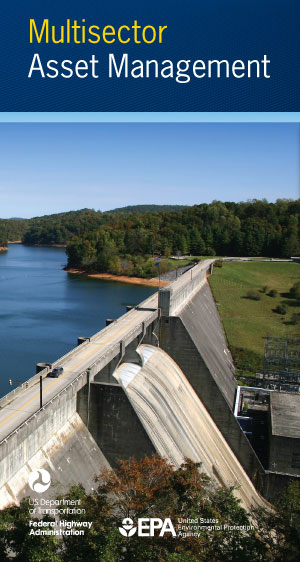U.S. Department of Transportation
Federal Highway Administration
1200 New Jersey Avenue, SE
Washington, DC 20590
202-366-4000
Focus
| Accelerating Infrastructure Innovations |
Publication Number: FHWA-HRT-10-008
Date: November 2009
 |
From Portland, Oregon, to Saco, Maine, communities across the United States and Canada are realizing the benefits of implementing multisector asset management (AM) processes and data tools. These tools can be used to monitor, evaluate, and make more informed decisions about how to best maintain vital infrastructure sectors, including highways, water, wastewater, airports, and mass transit. A new brochure available from the Federal Highway Administration (FHWA) and U.S. Environmental Protection Agency (EPA), Multisector Asset Management (Pub. No. FHWA-HIF-09-022), highlights examples from a joint FHWA and EPA report, Multisector Asset Management Case Studies. The report looks at five cities that are using AM to better understand infrastructure conditions, consider the service requirements across multiple sectors, and make choices about investment strategies. AM provides a coordinated approach to managing infrastructure assets over the course of their entire life cycle, thus improving performance, increasing safety, and providing greater value to the community. Using an AM approach, decisions on maintaining, repairing, renewing, or replacing infrastructure components are based on accurate data, economic analysis, and sound engineering strategies. "At the local level, cities are making decisions that involve multiple sectors. Asset management processes applied across the sectors result in innovations and greater efficiencies. Lessons learned from one sector offer practical advances that apply to another," says Steve Allbee of EPA. Whether a city or municipality is looking at highways, utilities, water, or other infrastructure sectors, AM implementation means asking five core questions:
|
Answering these questions provides the foundation for an AM plan, which establishes what is working well, where improvements are needed, and what type and quality of information are required to determine that an envisioned course of action is the best choice available.
Having used AM tools in its transportation sector for more than 20 years, the city of Portland, Oregon, began applying AM to its water and wastewater sectors over the past 5 years. While Portland has a long-term goal of developing a city-wide AM plan, AM data already play an important role in the city's budget process. Portland's Bureau of Planning develops annual reports on the status and condition of the city's physical infrastructure. These reports document the number of assets; their condition, replacement value, and current service levels; and the cost of unmet needs. They also include confidence level scores, which serve as a rough assessment of the quality of the data used in the development of the report. The reports are presented to Portland's city council at the start of annual budget work sessions.
Calgary, Canada, has operated a Corporate Asset Management Program since 2004. The program coordinates AM across 13 infrastructure-related business units, including roads, utilities, water, and waste and recycling. Asset Management Plans (AMPs) are being prepared for each business unit, with a long-term goal of combining all of the plans into one Corporate AMP, which will provide both an integrated plan for how services will be delivered and a citywide infrastructure investment strategy. The AM program is used to better justify capital and maintenance expenses to elected officials and the public.
Smaller communities are also benefiting from AM approaches. Saco, Maine, for example, is applying AM principles across its wastewater and transportation sectors. This city of 18,000 launched its multisector AM program in 2007. Using a collaborative approach, the city established a common framework that includes definitions of AM and a 10-step implementation roadmap before embarking on department-specific initiatives to strengthen AM practices. Saco has realized numerous benefits from applying AM. City departments, for example, are now looking at assets on the basis of sustainability, life cycle costs, and future financial effects.
"As budgets become more accurate, the information provided through asset management will allow a rational decision process for capital investment and maintenance," says Saco Public Works Director Michael Bolduc. "The most critical information for decisionmakers is an understanding of the condition of the assets today and how well they are performing in relationship to our residents' expectations. It is critical to know the condition of the asset, whether it is functioning as needed, whether it is functioning efficiently, and what the cost is to maintain the asset."
The AM approach also supports Saco's goal of being a green and sustainable city. The city recently hired a Sustainability Coordinator, who will be responsible for incorporating AM into energy and sustainability projects.
Multisector Asset Management is available online at www.fhwa.dot.gov/asset/if09022/index.cfm. To obtain a printed copy or for more information about multisector AM, contact Stephen J. Gaj, Leader of the System Management and Monitoring Team in FHWA's Office of Asset Management, 202-366-1336 (email: stephen.gaj@fhwa.dot.gov). The Multisector Asset Management Case Studies report is available at assetmanagement.transportation.org (click on Topic Area b., "Innovation and Success"), or at www.epa.gov/owm/assetmanage/index.htm.
 |
| Asset management data play an important role in Portland, Oregon's budget process. |
 |
Calgary, Canada, coordinates asset management across 13 infrastructure-related business units, including roads, utilities, and water. |